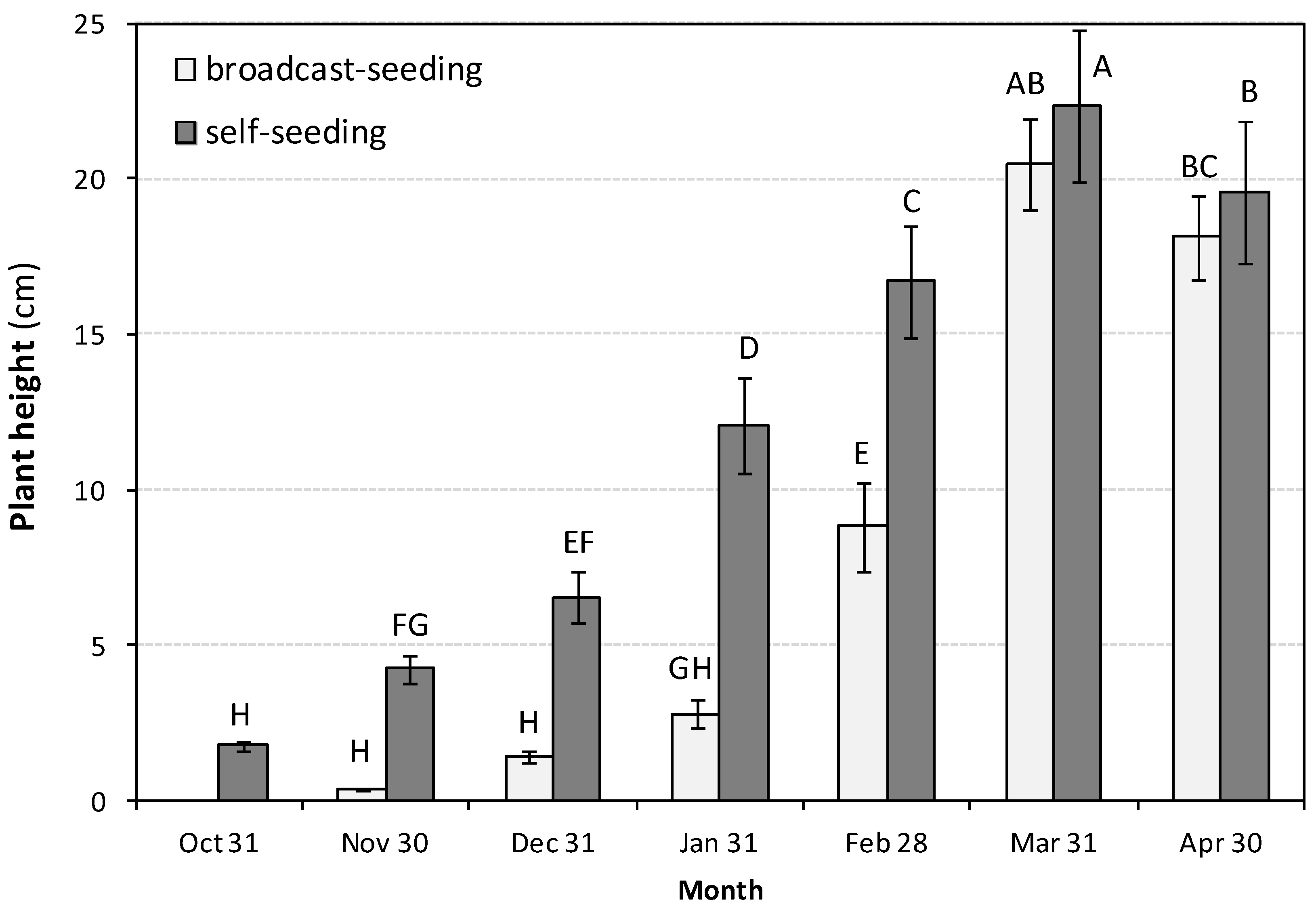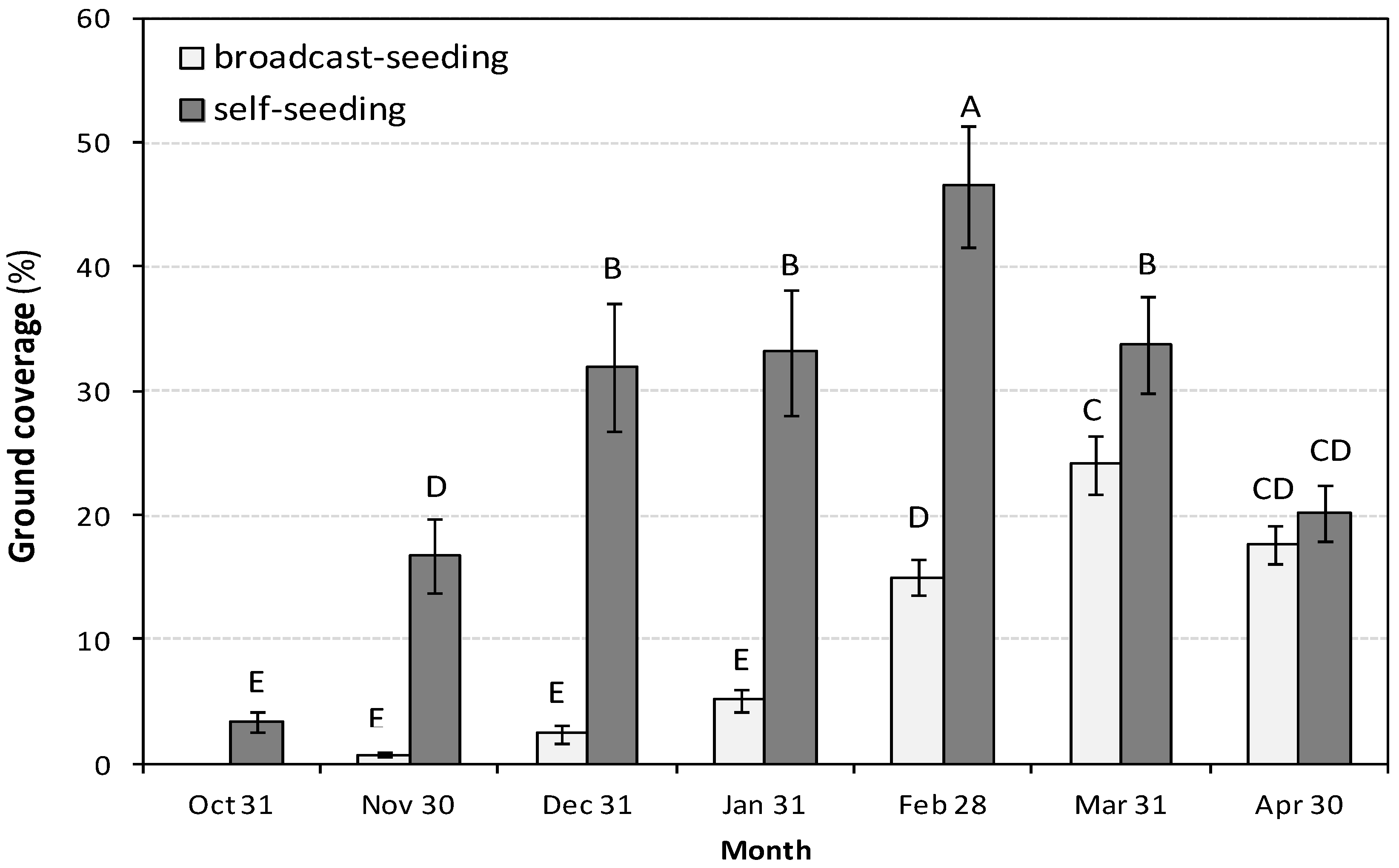The Self-Seeding of Anthemis arvensis L. for Cover Crop in Olive Groves under Intense Rabbit Grazing
Abstract
:1. Introduction
2. Materials and Methods
2.1. Study Area
2.2. Experimental Design and Measurements
2.3. Statistical Analysis
3. Results
4. Discussion
5. Conclusions
Author Contributions
Funding
Acknowledgments
Conflicts of Interest
References
- García-Ruiz, J.M. The effects of land uses on soil erosion in Spain: A review. Catena 2010, 81, 1–11. [Google Scholar] [CrossRef]
- Symeonakis, E.; Calvo-Cases, A.; Arnau-Rosalen, E. Land use change and land degradation in South-eastern Mediterranean Spain. Environ. Manag. 2007, 40, 80–94. [Google Scholar] [CrossRef] [PubMed]
- Scheidel, A.; Krausmann, F. Diet, trade and land use: A socio-ecological analysis of the transformation of the olive oil system. Land Use Policy 2011, 28, 47–56. [Google Scholar] [CrossRef]
- Muñoz-Rojas, M.; Jordán, A.; Zavala, L.M.; de la Rosa, D.; Abd-Elmabod, S.K.; Anaya-Romero, M. Impact of land use and land cover changes on organic carbon stocks in Mediterranean soils (1956–2007). Land Degrad. Dev. 2015, 26, 168–179. [Google Scholar] [CrossRef]
- Panagos, P.; Standardi, G.; Borrelli, P.; Lugato, E.; Montanarella, L.; Bosello, F. Cost of agricultural productivity loss due to soil erosion in the European Union: From direct cost evaluation approaches to the use of macroeconomic models. Land Degrad. Dev. 2018, 29, 471–484. [Google Scholar] [CrossRef]
- Milgroom, J.; Soriano, M.A.; Garrido, J.M.; Gómez, J.A.; Fereres, E. The influence of the shift from conventional to organic olive farming on soil management and erosion risk in Southern Spain. Renew. Agric. Food Syst. 2007, 22, 1–10. [Google Scholar] [CrossRef]
- Gómez, J.A.; Infante-Amate, J.; González de Molina, M.; Vanwalleghem, T.; Taguas, E.V.; Lorite, I. Olive Cultivation, its Impact on Soil Erosion and its Progression into Yield Impacts in Southern Spain in the Past as a Key to a Future of Increasing Climate Uncertainty. Agriculture 2014, 4, 170–198. [Google Scholar] [CrossRef] [Green Version]
- CAGPDS (Consejería de Agricultura, Ganadería, Pesca y Desarrollo Sostenible). Avance de Superficies y Producciones; Junta de Andalucía, CAGPDS: Seville, Spain; Available online: https://www.juntadeandalucia.es/organismos/agriculturaganaderiapescaydesarrollosostenible/consejeria/sobre-consejeria/estadisticas/paginas/agrarias-superficies-producciones.html (accessed on 11 July 2019).
- EC (European Commission). The Common Agricultural Policy at a Glance. Aims of the Common Agricultural Policy; EC: Brussels, Belgium; Available online: https://ec.europa.eu/info/food-farming-fisheries/key-policies/common-agricultural-policy/cap-glance_en#title (accessed on 11 July 2019).
- Langdale, G.W.; Blevins, R.L.; Karlen, D.L.; McCool, D.K.; Nearing, M.A.; Skidmore, E.L.; Thomas, A.W.; Tyler, D.D.; Williams, J.R. Cover crop effects on soil erosion by wind and water. In Cover Crops for Clean Water; Hargrove, W.L., Ed.; Soil and Water Conservation Society: Ankeny, IA, USA, 1991; pp. 15–22. [Google Scholar]
- Gómez, J.A.; Llewellyn, C.; Basch, G.; Sutton, P.B.; Dyson, J.S.; Jones, C.A. The effects of cover crops and conventional tillage on soil and runoff loss in vineyards and olive groves in several Mediterranean countries. Soil Use Manag. 2011, 27, 502–514. [Google Scholar] [CrossRef] [Green Version]
- Ruiz-Colmenero, M.; Bienes, R.; Eldridge, D.J.; Marques, M.J. Vegetation cover reduces erosion and enhances soil organic carbon in a vineyard in the central Spain. Catena 2013, 104, 153–160. [Google Scholar] [CrossRef]
- EC-JRC (European Commission, Joint Research Centre). Good Agricultural and Environmental Conditions (GAEC); EC, JRC: Brussels, Belgium; Available online: https://marswiki.jrc.ec.europa.eu/wikicap/index.php/Good_Agricultural_and_Environmental_Conditions_%28GAEC%29 (accessed on 11 July 2019).
- Gómez, J.A.; Guzmán, M.G.; Giráldez, J.V.; Fereres, E. The influence of cover crops and tillage on water and sediment yield, and on nutrient, and organic matter losses in an olive orchard on a sandy loam soil. Soil Tillage Res. 2009, 106, 137–144. [Google Scholar] [CrossRef] [Green Version]
- Gómez, J.A.; Sobrinho, T.A.; Giráldez, J.V.; Fereres, E. Soil management effects on runoff, erosion and soil properties in an olive grove of Southern Spain. Soil Tillage Res. 2009, 102, 5–13. [Google Scholar] [CrossRef]
- Carpio, A.J.; Castro, J.; Mingo, V.; Tortosa, F.S. Herbaceous cover enhances the squamate reptile community in woody crops. J. Nat. Conserv. 2017, 37, 31–38. [Google Scholar] [CrossRef]
- Carpio, A.J.; Castro, J.; Tortosa, F.S. Arthropod biodiversity in olive groves under two soil management systems: Presence versus absence of herbaceous cover crop. Agric. For. Entomol. 2019, 21, 58–68. [Google Scholar] [CrossRef]
- Gómez, J.A.; Campos, M.; Guzmán, G.; Castillo-Llanque, F.; Vanwalleghem, T.; Lora, Á.; Giráldez, J.V. Soil erosion control, plant diversity, and arthropod communities under heterogeneous cover crops in an olive orchard. Environ. Sci. Pollut. Res. 2018, 25, 977–989. [Google Scholar]
- Guerrero-Casado, J.; Carpio, A.J.; Prada, L.M.; Tortosa, F.S. Short communication. The role of rabbit density and the diversity of weeds in the development of cover crops in olive groves. Span. J. Agric. Res. 2015, 13, 7. [Google Scholar] [CrossRef] [Green Version]
- Carpio, A.J.; Soriano, M.A.; Guerrero-Casado, J.; Prada, L.M.; Tortosa, F.S.; Lora, A.; Gómez, J.A. Evaluation of an unpalatable species (Anthemis arvensis L.) as an alternative cover crop in olive groves under high grazing pressure by rabbits. Agric. Ecosyst. Environ. 2017, 246, 48–54. [Google Scholar] [CrossRef]
- Conservation Technology Information Center (CTIC). National Survey of Conservation Tillage Practices; CTIC: West Lafayette, IN, USA, 2004. [Google Scholar]
- Sarrantonio, M. Building soil fertility and tilth with cover crops. In Managing Cover Crops Profitably, 3rd ed.; Clark, A., Ed.; Sustainable Agriculture Research & Education (USDA): Beltsville, MD, USA, 2007; pp. 16–24. [Google Scholar]
- Evers, G.; Nelson, L.R. Grazing termination date influence on annual rye-grass seed production and reseeding in the South-Eastern USA. Crop. Sci. 2000, 40, 1724–1728. [Google Scholar] [CrossRef]
- Neto, A.B.; Savian, J.V.; Schons, R.M.T.; Bonnet, O.J.F.; do Canto, M.W.; de Moraes, A.; Lemaire, G.; de Faccio Carvalho, P.C. Italian ryegrass establishment by self-seeding in integrated crop-livestock systems: Effects of grazing management and crop rotation strategies. Eur. J. Agron. 2014, 53, 67–73. [Google Scholar] [CrossRef]
- Soriano, M.A.; Cabezas, J.M.; Ramos, A.; Lora, A.; Gómez, J.A. Characterization of Cover Crops for Use in Olive Groves and Vineyards in Certified Systems under Mediterranean Conditions; Agro Environ 2016, 10th International Symposium on Agriculture and the Environment; Purdue University: West Lafayette, IN, USA, 2016. [Google Scholar]
- Gómez, J.A.; Soriano, M.A. Evaluation of the suitability of three autochthonous herbaceous species as cover crops under Mediterranean conditions through the calibration and validation of a temperature-based phenology model. Agric. Ecosyst. Environ. 2020, 291, 106788. [Google Scholar] [CrossRef]
- Kay, Q.O.N. Biological Flora of the British Isles: Anthemis arvensis L. J. Ecol. 1971, 59, 637–648. [Google Scholar] [CrossRef]
- Instituto de Investigación y Formación Agraria y Pesquera (IFAPA). Estaciones agroclimáticas; Junta de Andalucía, IFAPA: Seville, Spain; Available online: https://www.juntadeandalucia.es/agriculturaypesca/ifapa/ria/ (accessed on 11 July 2019).
- Barrio, I.C.; Villafuerte, R.; Tortosa, F.S. Can cover crops reduce rabbit-induced damages in vineyards in southern Spain? Wildl. Biol. 2012, 18, 88–96. [Google Scholar] [CrossRef] [Green Version]
- Riccobono, L.; Maggio, A.; Bruno, M.; Spadaro, V.; Raimondo, F.M. Chemical composition and antimicrobial activity of the essential oils of some species of Anthemis sect. Anthemis (Asteraceae) from Sicily. Nat. Prod. Res. 2017, 31, 2759–2767. [Google Scholar] [CrossRef] [PubMed]
- International Union of Soil Sciences (IUSS) Working Group WRB. World Reference Base for Soil Resources 2014, update 2015. International Soil Classification System for Naming Soils and Creating Legends for Soil Maps; World Soil Resources Reports No. 106; FAO: Rome, Italy, 2015. [Google Scholar]
- Luscier, J.D.; Thompson, W.L.; Wilson, J.M.; Gorham, B.E.; Dragut, L.D. Using digital photographs and object-based image analysis to estimate percent ground cover in vegetation plots. Front. Ecol. Environ. 2006, 4, 408–413. [Google Scholar] [CrossRef] [Green Version]
- Allen, R.G.; Pereira, L.S.; Raes, D.; Martin, S. Crop. Evapotranspiration—Guidelines for Computing Crop Water Requirements; FAO Irrigation and Drainage Paper 56; FAO: Rome, Italy, 1998. [Google Scholar]
- Francis, C.; Thornes, J. Runoff hydrographs from three Mediterranean vegetation cover types. In Vegetation and Erosion; Thornes, J.B., Ed.; Wiley: Chichester, UK, 1990; pp. 363–384. [Google Scholar]
- Dabney, S.M.; Delgado, J.A.; Reeves, D.W. Using winter cover crops to improve soil and water quality. Commun. Soil Sci. Plant Anal. 2001, 32, 1221–1250. [Google Scholar] [CrossRef]
- Gimeno-García, E.; Andreu, V.; Rubio, J. Influence of vegetation recovery on water erosion at short and medium-term after experimental fires in a Mediterranean shrub land. Catena 2007, 69, 150–160. [Google Scholar] [CrossRef] [Green Version]
- Salisbury, E.J. Weeds and Aliens; Collins: London, UK, 1961. [Google Scholar]
- Schultz, B.; Davison, J. Scentless Chamomile: Taxonomy, Ecology, and Control; University of Nevada, Circular Fact Sheet FS-02-85; Cooperative Extension Service (UNCE): Reno, NV, USA, 2002. [Google Scholar]
- Fracchiolla, M.; Terzi, M.; Frabboni, L.; Caramia, D.; Lasorella, C.; de Giorgio, D.; Montemurro, P.; Cazzato, E. Influence of different soil management practices on ground-flora vegetation in an almond orchard. Renew. Agric. Food Syst. 2016, 31, 300–308. [Google Scholar] [CrossRef]


| Date | 2015–2016 | 2016–2017 | ||
|---|---|---|---|---|
| P (mm) | ETo (mm) | P (mm) | ETo (mm) | |
| 30 September | 10 | 139 | 3 | 157 |
| 31 October | 63 | 217 | 80 | 249 |
| 30 November | 119 | 268 | 146 | 292 |
| 31 December | 123 | 311 | 146 | 325 |
| 31 January | 194 | 345 | 162 | 368 |
| 28 February | 242 | 393 | 199 | 414 |
| 31 March | 264 | 480 | 278 | 504 |
| 30 April | 367 | 584 | 318 | 636 |
| Variables | df | Ground Cover | Plant Height | ||
|---|---|---|---|---|---|
| F | p-Value | F | p-Value | ||
| (Intercept) | 1 | 5.39 | 0.0219 | 8.84 | 0.0035 |
| Sowing Method | 1 | 237.31 | <0.0001 | 88.48 | <0.0001 |
| Date (growth cycle) | 5 | 25.57 | <0.0001 | 133.78 | <0.0001 |
| Sowing Method × Date | 5 | 13.87 | <0.0001 | 5.36 | 0.0002 |
© 2020 by the authors. Licensee MDPI, Basel, Switzerland. This article is an open access article distributed under the terms and conditions of the Creative Commons Attribution (CC BY) license (http://creativecommons.org/licenses/by/4.0/).
Share and Cite
Carpio, A.J.; Soriano, M.-A.; Gómez, J.A.; Tortosa, F.S. The Self-Seeding of Anthemis arvensis L. for Cover Crop in Olive Groves under Intense Rabbit Grazing. Agronomy 2020, 10, 1412. https://doi.org/10.3390/agronomy10091412
Carpio AJ, Soriano M-A, Gómez JA, Tortosa FS. The Self-Seeding of Anthemis arvensis L. for Cover Crop in Olive Groves under Intense Rabbit Grazing. Agronomy. 2020; 10(9):1412. https://doi.org/10.3390/agronomy10091412
Chicago/Turabian StyleCarpio, Antonio J., María-Auxiliadora Soriano, José A. Gómez, and Francisco S. Tortosa. 2020. "The Self-Seeding of Anthemis arvensis L. for Cover Crop in Olive Groves under Intense Rabbit Grazing" Agronomy 10, no. 9: 1412. https://doi.org/10.3390/agronomy10091412
APA StyleCarpio, A. J., Soriano, M. -A., Gómez, J. A., & Tortosa, F. S. (2020). The Self-Seeding of Anthemis arvensis L. for Cover Crop in Olive Groves under Intense Rabbit Grazing. Agronomy, 10(9), 1412. https://doi.org/10.3390/agronomy10091412






